
The National Museum of Natural History is a natural history museum administered by the Smithsonian Institution, located on the National Mall in Washington, D.C., United States. It has free admission and is open 364 days a year. In 2016, with 7.1 million visitors, it was the eleventh most visited museum in the world and the most visited natural history museum in the world. Opened in 1910, the museum on the National Mall was one of the first Smithsonian buildings constructed exclusively to hold the national collections and research facilities. The main building has an overall area of 1.5 million square feet (140,000 m2) with 325,000 square feet (30,200 m2) of exhibition and public space and houses over 1,000 employees.
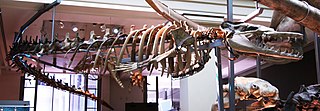
Basilosaurus is a genus of large, predatory, prehistoric archaeocete whale from the late Eocene, approximately 41.3 to 33.9 million years ago (mya). First described in 1834, it was the first archaeocete and prehistoric whale known to science. The first fossils were discovered along the Gulf Coast of the United States, along with a few fossils in the eastern U.S., attributed to the type species B. cetoides. They were originally thought to be of a giant reptile, hence the suffix "-saurus", Ancient Greek for "lizard". The animal was later found to be an early marine mammal, which prompted attempts at renaming the creature, which failed as zoological nomenclature dictates using the original name given. Fossils were later found of the second species, B. isis, in 1904 in North Africa, more specifically the countries of Egypt, Jordan, Tunisia and Morocco. Basilosaurus has a possible record in New Zealand and Seymour Island in Antarctica.

Dorudon ("spear-tooth") is a genus of extinct basilosaurid ancient whales that lived alongside Basilosaurus 40.4 to 33.9 million years ago in the Eocene. They were about 5 m (16 ft) long and fed on small fish and mollusks. Dorudon lived in warm seas around the world. Fossils have been found along the former shorelines of the Tethys Sea in present-day Egypt and Pakistan, as well as in the United States, New Zealand, and Western Sahara.
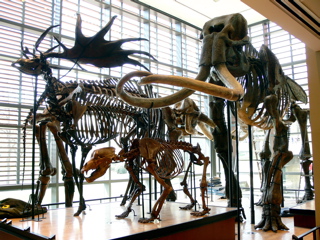
The Beneski Museum of Natural History, Amherst College is located on the campus of Amherst College in Amherst, Massachusetts. It showcases fossils and minerals collected locally and abroad, many by past and present students and professors. The Museum is located in the Beneski Earth Sciences Building, completed in 2006. It is a member of Museums10.

Zygorhiza ("Yoke-Root") is an extinct genus of basilosaurid early whale known from the Late Eocene of Louisiana, Alabama, and Mississippi, United States, and the Bortonian to the late Eocene of New Zealand . Specimens reported from Europe are considered Dorudontinae incertae sedis.

The Museum of Comparative Zoology, full name "The Louis Agassiz Museum of Comparative Zoology", often abbreviated simply to "MCZ", is the zoology museum located on the grounds of Harvard University in Cambridge, Massachusetts. It is one of three natural history research museums at Harvard whose public face is the Harvard Museum of Natural History. Harvard MCZ's collections consist of some 21 million specimens, of which several thousand are on rotating display at the public museum. The current director of the Museum of Comparative Zoology is James Hanken, the Louis Agassiz Professor of Zoology at Harvard University.

The Museum of the Earth is a natural history museum located in Ithaca, New York. The museum was opened in 2003 as part of the Paleontological Research Institution (PRI), an independent organization pursuing research and education in the history of the Earth and its life. Both PRI and the Museum of the Earth are formally affiliated with Cornell University. The Museum of the Earth is home to Earth science exhibits and science-related art displays with a focus on the concurrent evolution of the Earth and life.
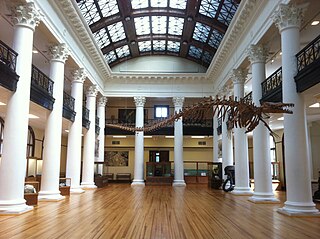
The Alabama Museum of Natural History is the state's natural history museum, located in Smith Hall at the University of Alabama campus in Tuscaloosa. The oldest museum in the state, it was founded in 1831. The exhibits depict the natural diversity of Alabama from the Age of Dinosaurs, the Coal Age, and the Ice Age. Collections include items relating to geology, zoology, mineralogy, paleontology, ethnology, history, and photography. The Grand Gallery Exhibition Hall houses a replica of a Basilosaurus cetoides, an Eocene whale that has been designated as the State Fossil. Exhibits of special interest include the skull of an American mastodon dredged from the Tombigbee River near Demopolis and the Hodges meteorite. The latter hit a woman as it fell to earth near Sylacauga on November 30, 1954. The museum sponsors expeditions throughout the year, as it has since 1979.

The Academy of Science - St. Louis is a non-profit organization in St. Louis, Missouri, dedicated to science literacy and education. It was founded in 1856 by a group of scientists and businessmen in St. Louis, including George Engelmann and James B. Eads, the Academy has been involved in many science-related activities in the city. It ran a Museum of Science and Natural History in Clayton, Missouri, and was involved in the efforts to raise funding for the St. Louis Science Center. The Academy uses its resources to expand scientific outreach, education, resource sharing, and the recognition of scientific accomplishment.
Egypt has many fossil-bearing geologic formations, in which many dinosaurs have been discovered.

The University of Michigan Museum of Natural History is a natural history museum in Ann Arbor, Michigan, United States. The museum recently moved to a new location at 1105 North University Avenue, in the University of Michigan Biological Sciences Building. It will reopen in April 2019.
Pontogeneus is a genus of extinct cetacean known from fossils recovered from Late Eocene sediments of the southeastern United States.
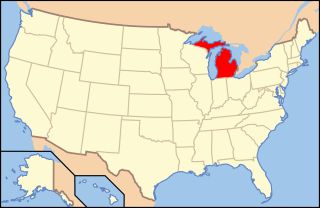
Paleontology in Michigan refers to paleontological research occurring within or conducted by people from the U.S. state of Michigan. During the Precambrian, the Upper Peninsula was home to filamentous algae. The remains it left behind are among the oldest known fossils in the world. During the early part of the Paleozoic Michigan was covered by a shallow tropical sea which was home to a rich invertebrate fauna including brachiopods, corals, crinoids, and trilobites. Primitive armored fishes and sharks were also present. Swamps covered the state during the Carboniferous. There are little to no sedimentary deposits in the state for an interval spanning from the Permian to the end of the Neogene. Deposition resumed as glaciers transformed the state's landscape during the Pleistocene. Michigan was home to large mammals like mammoths and mastodons at that time. The Holocene American mastodon, Mammut americanum, is the Michigan state fossil. The Petoskey stone, which is made of fossil coral, is the state stone of Michigan.
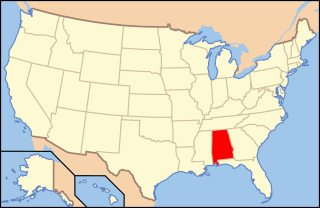
Paleontology in Alabama refers to paleontological research occurring within or conducted by people from the U.S. state of Alabama. Pennsylvanian plant fossils are common, especially around coal mines. During the early Paleozoic, Alabama was at least partially covered by a sea that would end up being home to creatures including brachiopods, bryozoans, corals, and graptolites. During the Devonian the local seas deepened and local wildlife became scarce due to their decreasing oxygen levels.

Paleontology in Missouri refers to paleontological research occurring within or conducted by people from the U.S. state of Missouri. The geologic column of Missouri spans all of geologic history from the Precambrian to present with the exception of the Permian, Triassic, and Jurassic. Brachiopods are probably the most common fossils in Missouri.
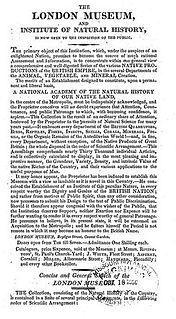
The London Museum and Institute of Natural History was a private natural history museum of the Georgian era. It opened to a paying public in 1807.

Geology Hall, formerly Geological Hall, also known as the Rutgers Geology Museum, is a building located in the historic Queens Campus section of Rutgers, The State University of New Jersey's College Avenue Campus in New Brunswick, New Jersey, United States. As part of the Queen's Campus historic district, Geology Hall was included on the New Jersey Register of Historic Places and the National Register of Historic Places in 1973. When Rutgers was selected as New Jersey's only land grant college in 1864, the college began to expand its curriculum to include instruction in science and agriculture. Rutgers president William Henry Campbell raised funds to construct a building to accommodate this expansion, and Geology Hall, designed by architect Henry Janeway Hardenbergh, was built in 1872.
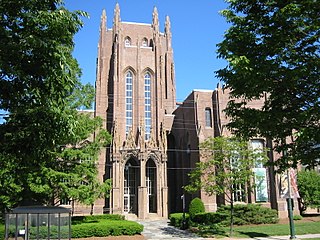
The Peabody Museum of Natural History at Yale University is among the oldest, largest, and most prolific university natural history museums in the world. It was founded by the philanthropist George Peabody in 1866 at the behest of his nephew Othniel Charles Marsh, the early paleontologist. Most known to the public for its Great Hall of Dinosaurs, which includes a mounted juvenile Brontosaurus and the 110-foot (34 m) long mural The Age of Reptiles, it also has permanent exhibits dedicated to human and mammal evolution; wildlife dioramas; Egyptian artifacts; and the birds, minerals and Native Americans of Connecticut.
















